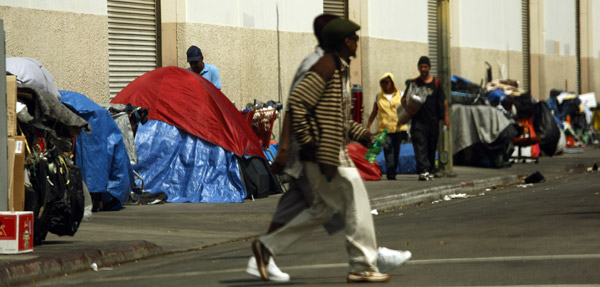L.A. County to focus funds on chronically homeless
-
(Client: Home For Good)
 Public officials and private donors will spend $105 million on more than a thousand chronic street dwellers. The marshaling of money is the most concrete product yet of an ambitious plan launched two years ago.
Public officials and private donors will spend $105 million on more than a thousand chronic street dwellers. The marshaling of money is the most concrete product yet of an ambitious plan launched two years ago.Los Angeles County’s most entrenched street dwellers make up just a quarter of its roughly 51,000 homeless people. But studies have found they account for a disproportionate share of public spending, including on hospital emergency rooms and jails.
On Thursday, public officials and private donors will announce that they are spending $105 million to move more than a thousand of the most chronic cases into permanent housing, part of a sweeping change in the way the county deals with homelessness.
“There’s a momentum that has been building in Los Angeles to change the paradigm of how we address homelessness,” said county Supervisor Zev Yaroslavsky. “We are spending tens of millions of dollars a year … but I think what is clear is that we haven’t intelligently invested that money in the past. What we want to do is a more intelligent way to invest in the homeless, not to have temporary solutions.”
The shift to target the chronically homeless means more resources will go to people who have lived on the streets for at least a year and suffer from a serious physical, mental or substance abuse problem.
But some emergency housing providers complain that there will be less money to assist families, youths and others who may need only temporary shelter.
“My concern is by focusing all the resources on the few, we are leaving the many out in the cold,” said the Rev. Andy Bales, who heads the Union Rescue Mission on L.A.’s skid row.
Officials have been talking for years about a greater focus on the chronically homeless. But the $105 million — which combines public money already set aside to assist the homeless and low-income people with new donations from philanthropic and business groups — marks a major step in bringing it to fruition.
About $88 million will go toward rental subsidies for 587 people over 15 years. In addition to using existing housing, $8.6 million will be used to develop 218 new units. The rest will be used to provide for counseling, treatment and other services designed to keep people off the streets.
The marshaling of money is the most concrete product yet of an ambitious plan launched by business and philanthropic leaders nearly two years ago with the goal of ending long-term and veteran homelessness in the county by 2016.
The Home for Good plan, an initiative of United Way of Greater Los Angeles and the Los Angeles Area Chamber of Commerce, proposed reallocating about $230 million in existing resources each year to pay for permanent supportive housing, which includes counseling and treatment to help keep people off the streets.
They hope additional money and resources will be dedicated to the effort in coming years.
The approach was pioneered locally by the county’s much-talked about Project 50 experiment and similar initiatives around the region, which have been praised not only for ending homelessness for many participants but also for saving municipalities money.
A county study found that Project 50, which began in late 2007 with the goal of housing the 50 most vulnerable, long-term homeless people on skid row, more than paid for itself, yielding a net savings of $238,700 over two years by cutting shelter, medical and jail costs.
Proponents of the approach argue that it is all the more important to spend strategically at a time when the state and federal governments are scaling back spending on affordable housing.
Jerry Newman, who co-chairs the Home for Good initiative, said that by prioritizing the most hard-core homeless for housing, “you take out the most costly portion of the issue, which will free up greater resources in the future.”
More than 100 community leaders and organizations — including the county Board of Supervisors, several cities and housing authorities — endorsed the Home for Good plan in its first year. In that period, more than 3,000 of the region’s long-term homeless and homeless veterans were placed in supportive housing, according to a report released in February.
A collaborative of 24 public and private contributors was formed to make the process more efficient. Members of the business and philanthropic communities, including the Conrad N. Hilton Foundation, committed $5 million to the effort, officials said. That money was then used to leverage $100 million in cash and services from the city and county of Los Angeles and from Pasadena.
In all, 30 nonprofits received awards ranging from $50,000 to $2.37 million to house the 1,018 people.
Maria Cabildo, president of East L.A. Community Corp., said her organization was able with a single application to secure a grant of $2.3 million from the Los Angeles Housing Department to help build homes for 32 chronically homeless veterans in Boyle Heights and more than $6 million in subsidies through the Housing Authority of the City of Los Angeles to help cover their rents in the coming years.
With that support, the organization could break ground as soon as January, shaving at least a year off what can be a complicated and time-consuming process, Cabildo said.
Follow the link to view the original posting on www.latimes.com http://www.latimes.com/news/local/la-me-homeless-money-20120816%2c0%2c7793080.story
